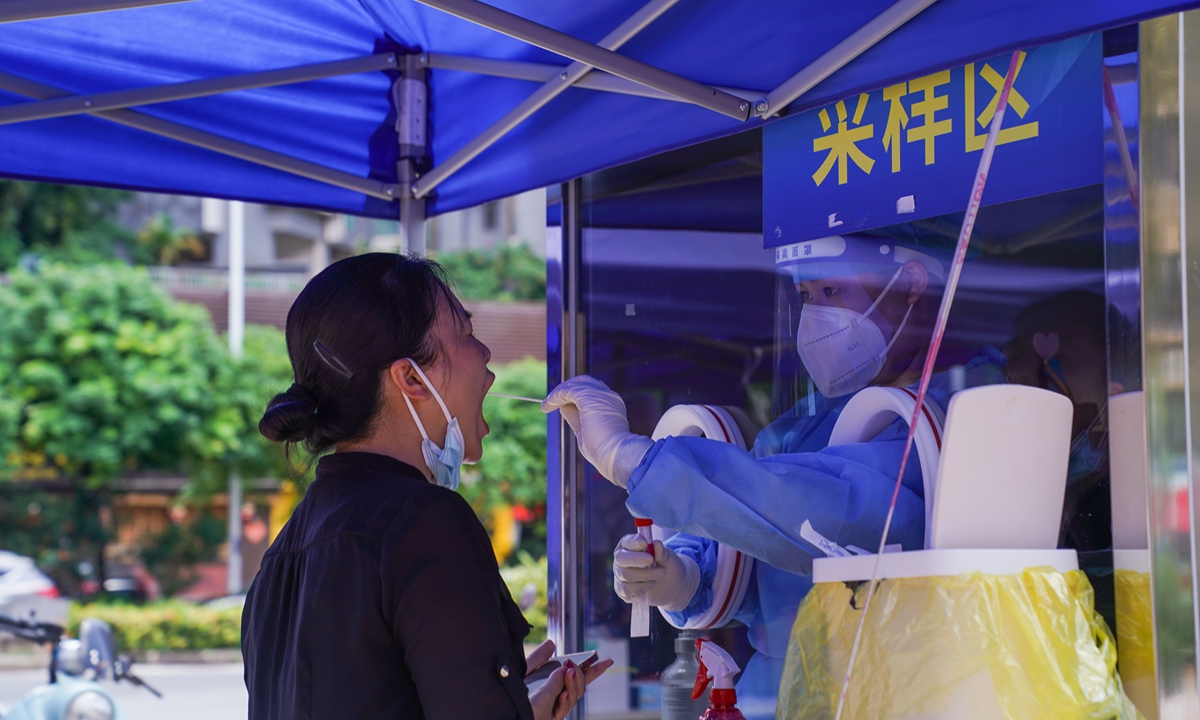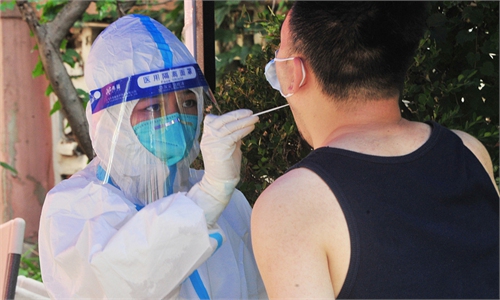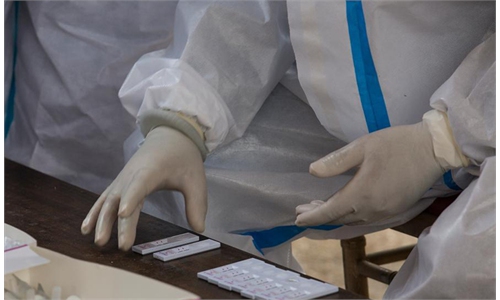
Residents take nucleic acid tests in Nanning, Southwest China's Guangxi Zhuang Autonomous Region on July 16, 2022. Photo: IC
China on Sunday reported nearly 600 local COVID-19 cases across some 16 provincial-level regions, the highest daily total in July, prompting concerns over a renewed COVID-19 upsurge, especially given the high transmissibility of new Omicron sub-variants.
The new wave of COVID-19 cases has been triggered by new emerging Omicron sub-variants, with nine such sub-variants all classified as forms of Omicron reportedly having been spreading among 12 regions since July.
However, health experts said July's flare-up is no surprise as the epidemic drags on and believe that China's current anti-COVD-19 measures, despite recent revisions, are still capable of combating the sporadic clusters characterized by highly-contagious Omicron mutations, while calling for enhanced early detection and response.
According to official data on Sunday, China recorded 106 COVID-19 cases and 474 asymptomatic cases for Saturday. The daily new cases are the highest reported in July 2022. Also, the daily tally in the Chinese mainland has surpassed 400 over the past three days.
Some regions, in particular, are seeing severe epidemic situations. For example, South China's Guangxi Zhuang Autonomous Region reported nine confirmed and 235 asymptomatic cases, while Northwest China's Gansu Province reported 53 confirmed and 105 asymptomatic cases. Shanghai, which recently emerged from a severe outbreak, is also seeing rising cases, with 26 local cases reported on Sunday.
In Guangxi, Beihai city has been hardest hit by Omicron, recording 241 daily positive cases. Driven by Omicron BA.2.3, cases in Beihai has surged, with a total of nine confirmed and 444 asymptomatic cases reported within six days since the first case was discovered on July 12.
As part of its efforts to cut off virus spread, Beihai is scheduled to roll out its fifth nucleic acid testing sweep. The previous four rounds of testing collected 3.94 million testing samples, officials said at a press conference on Sunday.
Meanwhile, Lanzhou, the provincial capital of Gansu, reported the most cases in the province, with 53 confirmed cases and 68 asymptomatic cases being recorded in a single day, lifting the total to 164 confirmed and 315 asymptomatic cases as of Sunday morning.
Health authorities had said the domestically-transmitted cases circulated in Gansu were identified as BA.2.38. The virulent strain has strong transmissibility and concealment, which is not conducive to early detection. The city started its sixth round of mass testing on Saturday, with more rounds expected.
In Shanghai, two new positive cases were reported on Sunday, in addition to 24 asymptomatic cases. At least three districts - Baoshan, Pudong New Area and Xuhui - have started mass testing.
Since July, the gene sequencing of domestically-transmitted cases in the Chinese mainland showed there are at least nine Omicron sub-variants coexisting across the nation, Jiankang Shibao, a health-focused newspaper, reported on Sunday.
Though this wave of COVID-19 flare-ups across the Chinese mainland has been evolving rapidly, a Beijing-based health expert told the Global Times that the current anti-COVID-19 measures are still effective if the "four early" practices are properly implemented - early identification, early reporting, early confirmation and early quarantine.
Jin Dongyan, a biomedical professor at the University of Hong Kong, told the Global Times on Sunday that Omicron sub-variants may not be the main driving factors behind the current round of COVID-19 flare-ups, because in the course of virus transmission, there is an average of 2 amino acid site changes every month, noting that differences among those sub-variants are minor in terms of transmission capability and immunoreactions.
Jin said the effective reproductive number (Re) is a key indicator of the growth of infections. But the Re number of either BA.2, BA.2.12, or BA.4 or BA.5 averages out at 1.5, meaning one positive case could infect one or two others, largely lower than 5.2 seen during the peak of the epidemic.
Although the new Omicron BA.5 sub-variant is becoming a major global strain and has caused local outbreaks in China, its pathogenicity has not changed significantly and China's recently revised anti-epidemic playbook is still capable of dealing with the new variants, experts noted.
"These measures in the ninth edition of the playbook are effective for both Omicron BA.4 and BA.5 sub-variants," Dong Xiaoping, Chinese CDC's chief virologist, said recently.
Experts are also calling for enhanced early detection amid the rising cases. Jin believed the fast spread of COVID-19 in Lanzhou and Beihai may be caused by the late detection of positive cases in the beginning of the transmission chain. Thus he called for regular tests, including the antigen detection, among high-risk population and regions.


